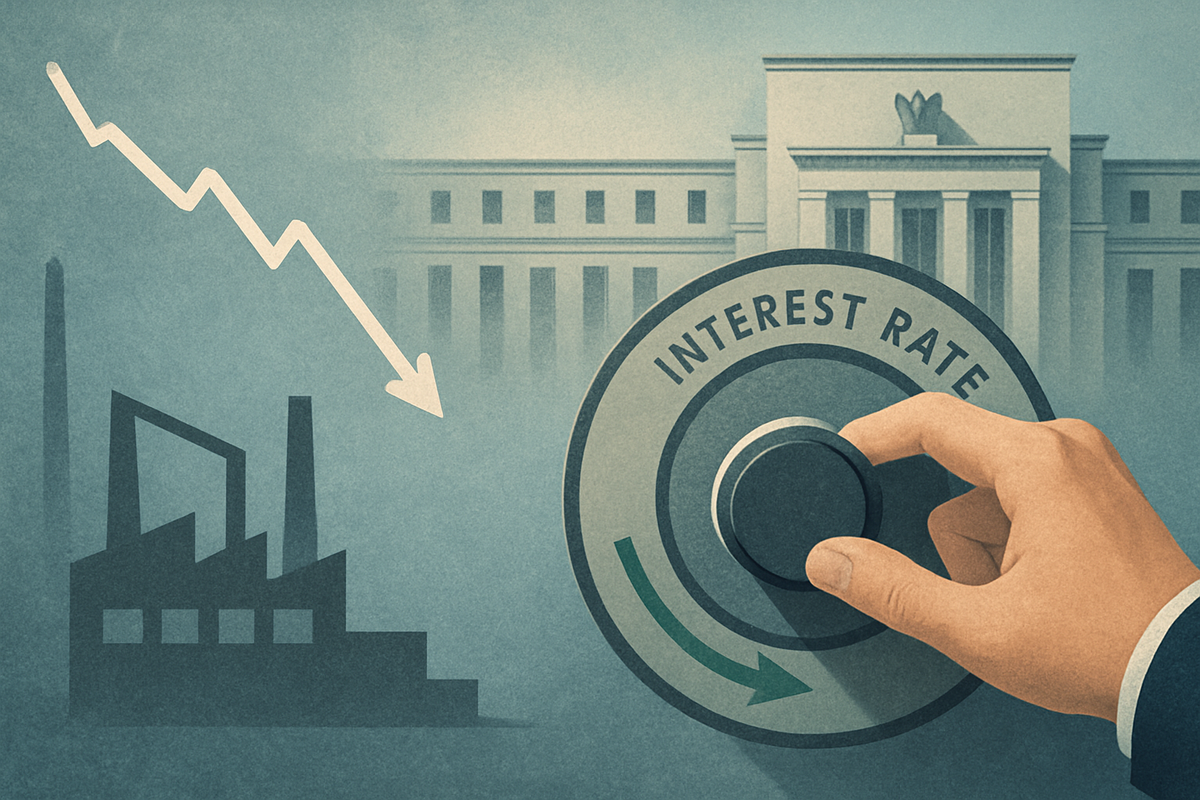
Washington D.C., October 1, 2025 – A confluence of weakening economic data, particularly in the labor market, has intensified market expectations for aggressive Federal Reserve interest rate cuts, marking a significant pivot in monetary policy. Following its initial rate reduction in September 2025, the Fed appears poised for further easing, signaling a proactive stance to avert a deeper economic slowdown. This shift has immediate implications for financial markets, impacting everything from bond yields to stock valuations, as investors recalibrate their strategies for a potentially more accommodative monetary environment.
The Federal Reserve's recent actions underscore a delicate balancing act between its dual mandate of achieving maximum employment and maintaining price stability. While inflation, though moderating from its peaks, still lingers above the central bank's 2% target, the increasing fragility of the labor market has become the more pressing concern, compelling policymakers to prioritize economic growth and job preservation.
A Deep Dive into the Economic Indicators Driving Fed Policy
The Federal Reserve's recent decision to cut interest rates, and the market's expectation for further reductions, are primarily driven by a series of concerning economic indicators. The most prominent among these is a noticeable cooling in the labor market. In August 2025, the U.S. economy added a mere 22,000 jobs, significantly missing economist expectations and representing a sharp decline from previous figures. July's job additions were also revised downwards to 79,000, and June even saw a loss of 13,000 jobs. Concurrently, the unemployment rate rose to 4.3% in August, its highest level since 2021, signaling a clear softening. Other labor market metrics, such as the Job Openings and Labor Turnover Survey (JOLTS), while showing modest job openings, revealed a dip in the hiring rate and a decline in quits, indicating a "low fire, low hire" dynamic.
Inflation data presents a more nuanced picture. While the Personal Consumption Expenditures (PCE) price index, the Fed's preferred inflation gauge, remained above the 2% target (headline PCE at 2.7% and core PCE at 2.9% over 12 months ending August), it has moderated from its peaks. However, August Consumer Price Index (CPI) data showed a reacceleration of inflation momentum, influenced partly by higher tariffs. Gross Domestic Product (GDP) growth also showed signs of moderation, with the U.S. economy growing at approximately 1.5% in the first half of 2025, a slowdown from the 2.5% seen in 2024. However, a robust upward revision to Q2 2025 GDP (to 3.0% or even 3.8% annualized), driven by consumer spending, briefly tempered some of the more aggressive rate cut bets in late September.
The timeline of these data releases and market reactions has been dynamic. Signals for a potential rate-cutting cycle emerged as early as July 2024. By December 2024, the Fed executed its first cut, bringing the federal funds rate to 4.25%-4.50%. However, unexpectedly weak jobs reports in August 2025, showing significant downward revisions to past job gains, dramatically increased the probability of a September cut, with bond futures traders pricing in over 80% odds. A "tame" July inflation report further solidified these expectations. The Federal Open Market Committee (FOMC) delivered a 25 basis point cut on September 17, 2025, bringing the federal funds rate to 4.00%-4.25%. Fed Chair Jerome Powell characterized this as a "risk management cut" to prevent further labor market deterioration. Despite some tempering from stronger Q2 GDP revisions and resilient jobless claims in late September, futures markets continue to price in a high probability (nearly 90%) of another rate cut in October and approximately a 65-70% probability of an additional move in December. The upcoming September jobs report, expected on October 3, 2025, is seen as crucial, with a weak report likely to "all but guarantee an October rate cut."
Key players in this unfolding scenario include Federal Reserve officials like Chairman Jerome Powell, who has emphasized a data-dependent approach and the "risk management" nature of the September cut. Governor Christopher Waller publicly supported the cut, while newly appointed Governor Stephen Miran notably dissented, advocating for a larger half-point cut. Economists and market analysts, such as Jeffrey Roach of LPL Financial and Aditya Bhave of Bank of America, largely attribute the Fed's pivot to the weakening labor market. Initial market reactions have seen bond yields fall after weak jobs data, reflecting increased bond prices. Equity markets have shown mixed reactions, with rate cut expectations generally supporting growth-oriented sectors, though stronger GDP data briefly led to declines in major indices. The U.S. dollar has generally weakened, while gold has surged to record highs, acting as a safe haven.
Corporate Fortunes: Who Wins and Who Loses from Lower Rates?
Anticipated Federal Reserve interest rate cuts are poised to reshuffle the deck for public companies across various sectors, creating both clear winners and those facing headwinds. The fundamental impact of lower interest rates revolves around reduced borrowing costs, increased consumer spending, enhanced investment opportunities, and shifts in stock market valuations.
Potential Winners:
- Real Estate and Homebuilders: This sector is among the most direct beneficiaries. Lower interest rates translate into reduced mortgage rates, making homeownership more affordable and stimulating demand. Companies like D.R. Horton (NYSE: DHI), Lennar (NYSE: LEN), PulteGroup (NYSE: PHM), and Toll Brothers (NYSE: TOL) are expected to see increased sales and potentially higher home prices. Construction suppliers such as Builders FirstSource (NASDAQ: BLDR) and Mohawk Industries (NYSE: MHK) could also gain from increased building activity. Real Estate Investment Trusts (REITs), especially in data centers, telecommunications, and healthcare, also benefit from lower debt costs and increased investor demand for yield.
- Consumer Discretionary: With lower borrowing costs on credit cards and auto loans, consumers tend to have more disposable income, leading to increased spending on non-essential goods and services. This directly boosts the revenues and profitability of companies in this sector. Examples include Nike (NYSE: NKE), Disney (NYSE: DIS), Netflix (NASDAQ: NFLX), Airbnb (NASDAQ: ABNB), and Tesla (NASDAQ: TSLA).
- Technology (Growth Stocks): Many technology firms are growth-oriented and rely on capital for research, development, and expansion. Lower borrowing costs reduce their financing expenses and make their future earnings more valuable when discounted at a lower rate, boosting their stock valuations. Tech giants like Microsoft (NASDAQ: MSFT), Apple (NASDAQ: AAPL), Alphabet (NASDAQ: GOOGL), and Meta (NASDAQ: META), along with IT services providers like Infosys (NYSE: INFY) and Wipro (NYSE: WIT), could see positive impacts.
- Industrials and Manufacturing: Cheaper capital encourages businesses to invest in capital-intensive projects, equipment upgrades, and facility expansions. This increased industrial activity translates into higher demand for machinery and related services, benefiting companies like Caterpillar (NYSE: CAT).
- Small-Cap and Mid-Cap Companies: These firms are often more sensitive to interest rate changes due to their greater reliance on borrowing for growth. Lower rates can provide a significant boost to their profitability and growth prospects, potentially leading to outsized stock performance.
- Utilities: Capital-intensive utilities benefit from lower borrowing costs for infrastructure projects. Their steady dividends also become more attractive to income-oriented investors when bond yields decline. Examples include NextEra Energy (NYSE: NEE), Duke Energy (NYSE: DUK), and American Water Works (NYSE: AWK).
- Financials (Nuanced Impact): While lower rates can compress net interest margins for banks, a stimulated economy can lead to increased loan demand (mortgages, business loans) and higher activity in capital markets. Large-cap banks like JPMorgan Chase (NYSE: JPM), Bank of America (NYSE: BAC), and Citigroup (NYSE: C) may see benefits from increased lending and capital markets activity. Regional banks like F.N.B. Corp (NYSE: FNB), with a focus on business loans, could also benefit.
Potential Losers or Less Benefited:
- Financial Institutions (Net Interest Margin Compression): The most immediate negative impact on banks and lenders is the compression of their net interest margins, as the interest earned on loans may decline faster than the interest paid on deposits.
- Cash-Heavy Companies: Businesses holding substantial cash reserves or those whose revenue is primarily derived from interest income will see reduced returns on their savings and investments as prevailing interest rates fall.
- Defensive Sectors (Relative Underperformance): In an environment of falling rates and an improving economic outlook, investors might rotate out of traditionally defensive sectors (e.g., some utilities, consumer staples, healthcare) into more growth-oriented or cyclical sectors, leading to relative underperformance. Companies like Procter & Gamble (NYSE: PG) or Coca-Cola (NYSE: KO) might be considered more resilient but could see less upside.
- Companies with Conservative Fiscal Practices: Firms that have avoided debt may find it harder to capitalize on lower borrowing costs for expansion, potentially struggling to adapt to intensified market dynamics.
Broader Implications: A Global Ripple Effect
The Federal Reserve's pivot towards interest rate cuts carries wider significance, extending beyond individual companies to influence broader industry trends, global economic dynamics, and regulatory frameworks. This strategic shift is largely a response to a cooling U.S. labor market and aims to sustain economic growth, drawing parallels with historical periods of economic adjustment.
Domestically, the anticipated rate cuts are expected to profoundly impact the housing market, making mortgages more affordable and stimulating demand. The auto sector could see increased consumer demand for vehicles due to reduced financing costs. Technology and growth-oriented sectors are poised for a boost as lower rates enhance the present value of future earnings and reduce borrowing costs for expansion. Increased consumer spending, fueled by lower interest rates, is expected to drive demand for manufactured goods and overall consumption. However, financial institutions might face pressure on their net interest margins as the spread between lending and deposit rates narrows.
Globally, a significant ripple effect is the likely weakening of the U.S. dollar. A weaker dollar makes U.S. exports more competitive internationally and imports more expensive, potentially shifting trade balances. This can influence global capital flows and currency dynamics. Emerging economies, particularly those with substantial dollar-denominated debt, could benefit from reduced interest payments. The Fed's decision can also trigger a global monetary policy shift, prompting other central banks to consider similar easing measures.
Regulatory and policy implications are also at play. The Fed's rate decisions interact with broader fiscal policies, such as ongoing tariff policies by the U.S. administration, which are acknowledged factors influencing inflation and business confidence. While rate cuts might aim to mitigate the economic drag from tariffs, tariffs could also limit the effectiveness of monetary policy in controlling inflation. Furthermore, the recurring threat of a government shutdown introduces significant regulatory uncertainty, potentially disrupting the release of vital economic data and challenging the Fed's data-dependent approach. Political pressures on rate decisions also remain a perennial concern, with the potential for erosion of Fed independence leading to slower long-term growth and persistently higher inflation.
Historically, the current period aligns with instances where the Fed undertakes "mid-cycle adjustments" or "risk management cuts" to address economic uncertainties. Precedents include the aggressive rate cuts during the 2007-2008 Financial Crisis to combat a deepening downturn, the swift reductions to zero during the early 2020 COVID-19 Pandemic to counter economic shutdowns, and the three modest cuts in 2019 in response to concerns over trade conflicts. These historical periods show that rate cuts, especially during "economic soft patches," have generally boosted investor confidence and stock markets. However, the Dallas Fed President's comparison to the 1970s, where misinterpreting slowing productivity led to inappropriate rate cuts that stoked inflation, serves as a cautionary tale, emphasizing the critical balance between price stability and maximum employment.
The Path Ahead: Navigating a New Monetary Landscape
The Federal Reserve's current trajectory suggests a continued easing of monetary policy, with both short-term and long-term implications for the economy and financial markets. The September 2025 rate cut was a clear signal, and analysts widely anticipate two more 25-basis-point reductions by the end of 2025, likely in October and December, bringing the federal funds rate to a range of 3.5%–3.75%. This short-term easing is primarily a "risk management cut" aimed at forestalling further deterioration in the labor market.
Looking further out, projections indicate a gradual, continued easing cycle through 2026 and 2027, with the federal funds rate potentially trending around 3.50% in 2026 and 3.25% in 2027, and some forecasts suggesting a target range of 2.25%-2.50% by the end of 2027. This long-term outlook is shaped by expectations of below-trend economic growth and the Fed's ongoing efforts to bring persistent inflation, projected at 3% for 2025, down towards its 2% target.
Strategic pivots for the Fed will involve maintaining a data-driven dovishness, prioritizing preemptive easing in response to a fragile labor market while balancing inflation concerns. The central bank faces a tension between its dual mandates, acknowledging there is "no risk-free path" forward. The job market's "peculiar equilibrium" of low layoffs but subdued hiring, influenced by high costs and tariffs, suggests that rate cuts alone may not fully resolve underlying structural issues. Furthermore, the risk of political interference challenging the Fed's independence and the fiscal instability from potential government shutdowns could complicate informed policy decisions by disrupting crucial economic data.
These developments present both market opportunities and challenges. On the opportunity side, equities, particularly growth stocks in technology, real estate, and consumer discretionary sectors, are expected to benefit from lower borrowing costs and reduced discount rates. Bonds could see increased values, with opportunities in long-duration Treasuries and Treasury Inflation-Protected Securities (TIPS). Lower mortgage rates, influenced by Fed cuts, can stimulate the real estate market. Gold often serves as a safe haven in environments with falling real interest rates. Business expansion is encouraged by cheaper capital, and a weaker U.S. dollar could boost international equities.
However, challenges persist. Financials may face margin compression, and returns on savings accounts and CDs will likely weaken. Tariff risks could continue to impact manufacturing and import-dependent industries. The risk of a mild recession or stagflation remains if rate cuts are a reaction to deeper economic fragility. An over-reliance on rate cuts may prove ineffective if underlying business problems stem from high costs and tight credit. Concerns about long-term inflation and government deficits could keep the long end of the yield curve elevated, potentially leading to a U-shaped curve.
Several potential scenarios for monetary policy and economic growth are plausible:
- Baseline "Soft Landing" Scenario: The Fed's intended outcome, with gradual economic cooling, inflation converging to 2%, and a stable labor market.
- Mild Recession/Deeper Slowdown Scenario: If easing is insufficient or new headwinds emerge, prompting more aggressive cuts.
- Resurgent Inflation Scenario: Unexpected inflation resurgence forcing the Fed to reverse course and raise rates again.
- Erosion of Fed Independence Scenario: Political interference leading to slower long-term growth and persistently higher inflation.
The Road Ahead: Vigilance and Adaptation for Investors
The Federal Reserve's September 2025 interest rate cut marks a pivotal moment, signaling the start of an easing cycle driven by concerns over a weakening labor market. This strategic pivot aims to manage economic risks and support growth, moving away from the prolonged period of higher rates. While inflation remains a persistent consideration, the Fed's immediate focus is on ensuring maximum employment, acknowledging the delicate balance required to fulfill its dual mandate.
Key takeaways from this development include the Fed's proactive "risk management" approach to a softening labor market, the divided opinions within the FOMC regarding the pace of easing, and the strong market expectation for at least two more 25-basis-point cuts by year-end. This shift generally provides a supportive backdrop for equity markets, particularly growth-oriented sectors, and influences bond yields, mortgage rates, and the U.S. dollar.
Moving forward, investors should maintain a high degree of vigilance. The market's trajectory will be heavily influenced by incoming economic data, especially inflation metrics like the Core PCE price index and various labor market indicators. Federal Reserve communications, including FOMC statements, meeting minutes, and speeches by Fed officials, will offer crucial insights into future policy decisions. The potential for a U.S. government shutdown poses a significant risk, as it could disrupt the release of vital economic data, hindering the Fed's ability to make informed decisions and increasing market volatility. Furthermore, ongoing tariff developments and global economic conditions will continue to shape the Fed's outlook and broader market dynamics.
In terms of portfolio strategy, investors may consider reallocating cash from declining short-term yields into short- to intermediate-term bonds. Adjusting equity exposure with a focus on small- and mid-cap companies, growth-oriented sectors, and those sensitive to interest rate changes could prove beneficial. Exploring alternative investments and inflation hedges may offer diversification and risk management in this evolving economic landscape. As policy rates are set to fall further, phasing excess liquidity into diversified portfolios, including quality bonds and equity income strategies, is recommended.
The lasting impact of these developments hinges on the Fed's ability to successfully navigate the complexities of a data-dependent environment, balancing inflation concerns with the imperative of fostering a healthy labor market. The coming months will be crucial in determining whether the Fed can orchestrate a "soft landing" or if the economy faces more significant challenges.
This content is intended for informational purposes only and is not financial advice.






